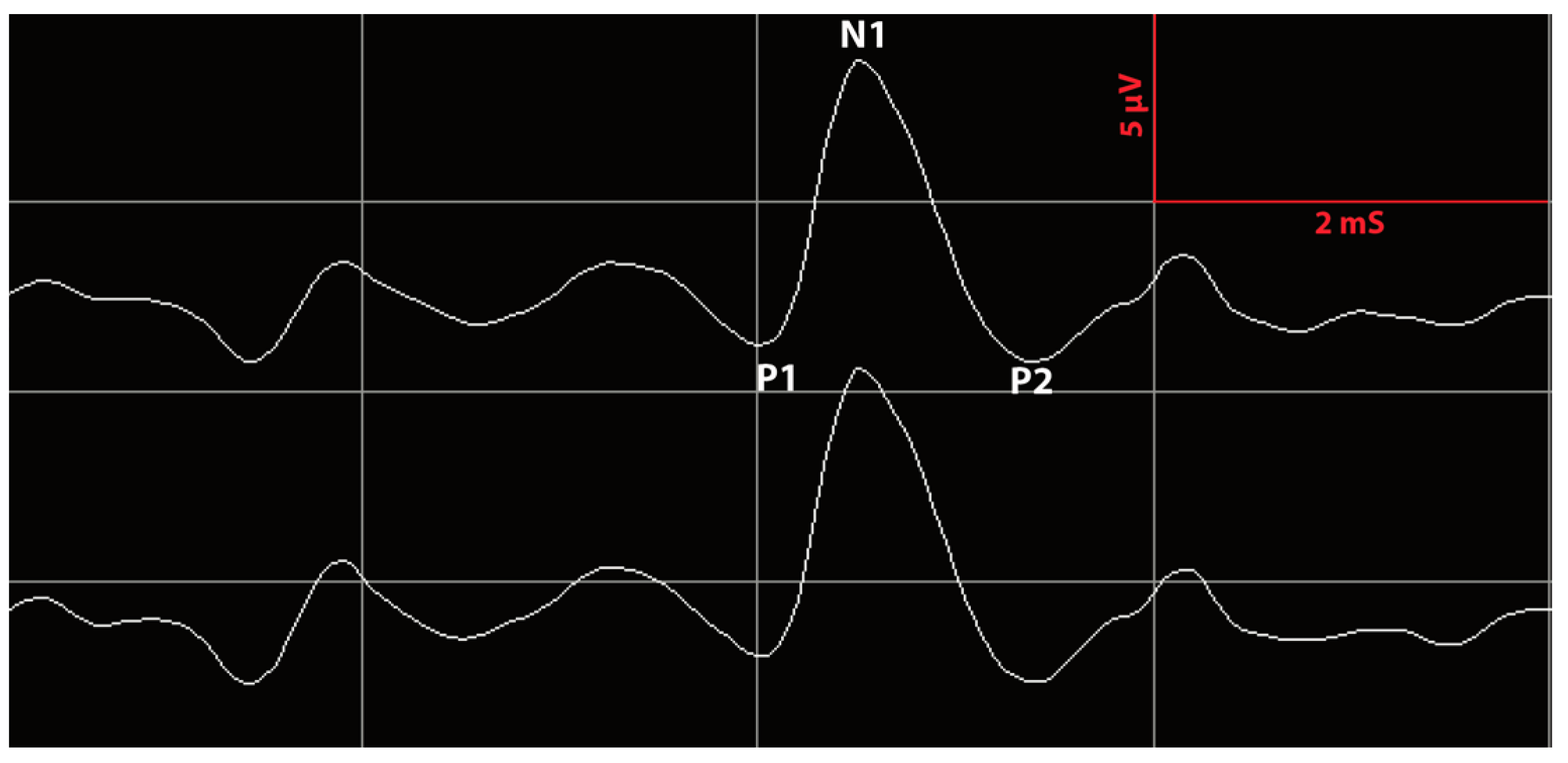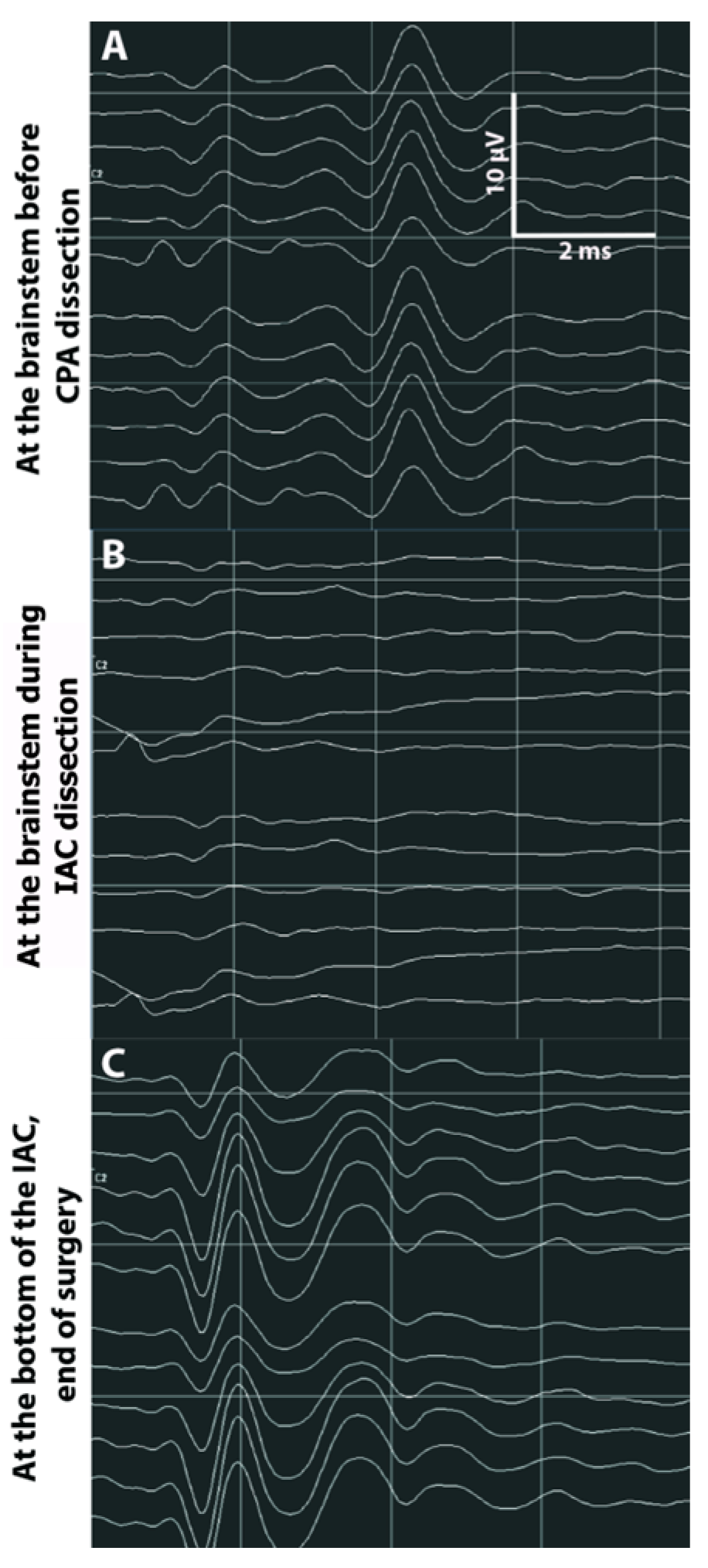Monitoring Cochlear Nerve Action Potential for Hearing Preservation in Medium/Large Vestibular Schwannoma Surgery: Tips and Pitfalls
Abstract
:1. Introduction
2. Material and Methods
2.1. Preoperative Data
2.2. Intraoperative CN Monitoring (IOCNM)
2.3. Intraoperative Facial Nersurfaceve Monitoring (IOFNM)
2.4. Surgical Technique
2.5. Postoperative Data
2.6. Statistical Analysis
3. Results
3.1. CNAP
3.2. ABR
3.3. Hearing Preservation
3.4. Postoperative Facial Nerve Function
3.5. Degree of Resection
4. Discussion and Conclusions
Author Contributions
Funding
Institutional Review Board Statement
Informed Consent Statement
Conflicts of Interest
References
- Frischer, J.M.; Gruber, E.; Schöffmann, V.; Ertl, A.; Höftberger, R.; Mallouhi, A.; Wolfsberger, S.; Arnoldner, C.; Eisner, W.; Knosp, E.; et al. Long-Term Outcome after Gamma Knife Radiosurgery for Acoustic Neuroma of All Koos Grades: A Single-Center Study. J. Neurosurg. 2018, 132, 388–397. [Google Scholar] [CrossRef] [PubMed]
- Goldbrunner, R.; Weller, M.; Regis, J.; Lund-Johansen, M.; Stavrinou, P.; Reuss, D.; Evans, D.G.; Lefranc, F.; Sallabanda, K.; Falini, A.; et al. EANO Guideline on the Diagnosis and Treatment of Vestibular Schwannoma. Neuro-Oncology 2020, 22, 31–45. [Google Scholar] [CrossRef] [PubMed]
- Stangerup, S.-E.; Caye-Thomasen, P. Epidemiology and Natural History of Vestibular Schwannomas. Otolaryngol. Clin. NA 2012, 45, 257–268. [Google Scholar] [CrossRef] [PubMed]
- Daoudi, H.; Lahlou, G.; Degos, V.; Sterkers, O.; Nguyen, Y.; Kalamarides, M. Improving Facial Nerve Outcome and Hearing Preservation by Different Degrees of Vestibular Schwannoma Resection Guided by Intraoperative Facial Nerve Electromyography. Acta Neurochir. 2020, 162, 1983–1993. [Google Scholar] [CrossRef] [PubMed]
- Bernardeschi, D.; Pyatigorskaya, N.; Vanier, A.; Bielle, F.; Smail, M.; Lamas, G.; Sterkers, O.; Kalamarides, M. Role of Electrophysiology in Guiding Near-Total Resection for Preservation of Facial Nerve Function in the Surgical Treatment of Large Vestibular Schwannomas. J. Neurosurg. 2018, 128, 903–910. [Google Scholar] [CrossRef]
- Carlson, M.L.; Lohse, C.M.; Link, M.J.; Tombers, N.M.; McCaslin, D.L.; Saoji, A.A.; Hutchins, M.; Yost, K.J. Development and Validation of a New Disease-Specific Quality of Life Instrument for Sporadic Vestibular Schwannoma: The Mayo Clinic Vestibular Schwannoma Quality of Life Index. J. Neurosurg. 2023, 138, 981–991. [Google Scholar] [CrossRef]
- Bernat, I.; Grayeli, A.B.; Esquia, G.; Zhang, Z.; Kalamarides, M.; Sterkers, O. Intraoperative Electromyography and Surgical Observations as Predictive Factors of Facial Nerve Outcome in Vestibular Schwannoma Surgery. Otol. Neurotol. 2010, 31, 306–312. [Google Scholar] [CrossRef]
- Daniel, R.T.; Tuleasca, C.; Rocca, A.; George, M.; Pralong, E.; Schiappacasse, L.; Zeverino, M.; Maire, R.; Messerer, M.; Levivier, M. The Changing Paradigm for the Surgical Treatment of Large Vestibular Schwannomas. J. Neurol. Surg. B Skull Base 2018, 79, S362–S370. [Google Scholar] [CrossRef]
- Hummel, M.; Perez, J.; Hagen, R.; Gelbrich, G.; Ernestus, R.-I.; Matthies, C. Auditory Monitoring in Vestibular Schwannoma Surgery: Intraoperative Development and Outcome. World Neurosurg. 2016, 96, 444–453. [Google Scholar] [CrossRef]
- Møller, A.R.; Jannetta, P.J. Compound Action Potentials Recorded Intracranially from the Auditory Nerve in Man. Exp. Neurol. 1981, 74, 862–874. [Google Scholar] [CrossRef]
- Li, X.; Liang, J.; Song, G.; Jiao, H. Using a Facial Nerve Stimulator to Record the Auditory Nerve Compound Action Potential to Locate the Auditory Nerve During Vestibular Schwannoma Resection. World Neurosurg. 2023, 175, e582–e592. [Google Scholar] [CrossRef] [PubMed]
- Zhan, K.Y.; Wick, C.C. Intraoperative Cochlear Nerve Monitoring in Vestibular Schwannoma Microsurgery. Otolaryngol. Clin. North Am. 2023, 56, 471–482. [Google Scholar] [CrossRef] [PubMed]
- Yamakami, I.; Ito, S.; Higuchi, Y. Retrosigmoid Removal of Small Acoustic Neuroma: Curative Tumor Removal with Preservation of Function. J. Neurosurg. 2014, 121, 554–563. [Google Scholar] [CrossRef] [PubMed]
- Ishikawa, M.; Kojima, A.; Terao, S.; Nagai, M.; Kusaka, G.; Naritaka, H. Cochlear Nerve Action Potential Monitoring for Preserving Function of an Unseen Cochlear Nerve in Vestibular Schwannoma Surgery. World Neurosurg. 2017, 106, 1057.e1–1057.e7. [Google Scholar] [CrossRef] [PubMed]
- American Academy of Otolaryngology-Head and Neck Surgery Foundation. Committee on Hearing and Equilibrium Guidelines for the Evaluation of Hearing Preservation in Acoustic Neuroma (Vestibular Schwannoma). Otolaryngol. Head Neck Surg. 1995, 113, 179–180. [Google Scholar] [CrossRef] [PubMed]
- Koos, W.T.; Day, J.D.; Matula, C.; Levy, D.I. Neurotopographic Considerations in the Microsurgical Treatment of Small Acoustic Neurinomas. J. Neurosurg. 1998, 88, 506–512. [Google Scholar] [CrossRef]
- House, J.; Brackmann, D. Facial Nerve Grading System. Otolaryngol. Head Neck Sur.g 1985, 93, 146–147. [Google Scholar] [CrossRef]
- Yamakami, I.; Oka, N.; Yamaura, A. Intraoperative Monitoring of Cochlear Nerve Compound Action Potential in Cerebellopontine Angle Tumour Removal. J. Clin. Neurosci. 2003, 10, 567–570. [Google Scholar] [CrossRef]
- Jackson, L.E.; Roberson, J.B. Acoustic Neuroma Surgery: Use of Cochlear Nerve Action Potential Monitoring for Hearing Preservation. Am. J. Otol. 2000, 21, 249–259. [Google Scholar] [CrossRef]
- Seol, H.J.; Kim, C.; Park, C.-K.; Kim, C.H.; Kim, D.G.; Chung, Y.-S.; Jung, H.-W. Optimal Extent of Resection in Vestibular Schwannoma Surgery: Relationship to Recurrence and Facial Nerve Preservation. Neurol. Med. Chir. 2006, 46, 176–180. [Google Scholar] [CrossRef]
- Wanibuchi, M.; Fukushima, T.; McElveen, J.T.; Friedman, A.H. Hearing Preservation in Surgery for Large Vestibular Schwannomas. J. Neurosurg. 2009, 111, 845–854. [Google Scholar] [CrossRef] [PubMed]
- Samii, M.; Gerganov, V.; Samii, A. Hearing Preservation after Complete Microsurgical Removal in Vestibular Schwannomas. Prog. Neurol. Surg. 2008, 21, 136–141. [Google Scholar] [CrossRef] [PubMed]
- Matthies, C.; Samii, M. Vestibular Schwannomas and Auditory Function: Options in Large T3 and T4 Tumors? Neurochirurgie 2002, 48, 461–470. [Google Scholar]
- Brackmann, D.E.; Green, J.D. Translabyrinthine Approach for Acoustic Tumor Removal. Otolaryngol. Clin. North Am. 1992, 25, 311–329. [Google Scholar] [CrossRef] [PubMed]
- Bonne, N.-X.; Risoud, M.; Wilkinson, E.P.; Aboukais, R.; Baroncini, M.; Lejeune, J.-P.; Vincent, C. Infrared Videoangiographic Assessment of Cochlear Nerve Vasculature during Middle Fossa Surgery. Laryngoscope 2016, 126, 2597–2600. [Google Scholar] [CrossRef]
- Lassaletta, L.; Aristegui, M.; Medina, M.; Aranguez, G.; Pérez-Mora, R.M.; Falcioni, M.; Gavilán, J.; Piazza, P.; Sanna, M. Ipsilateral Cochlear Implantation in Patients with Sporadic Vestibular Schwannoma in the Only or Best Hearing Ear and in Patients with NF2. Eur. Arch. Otorhinolaryngol. 2016, 273, 27–35. [Google Scholar] [CrossRef]
- West, N.; Sass, H.; Cayé-Thomasen, P. Sporadic and NF2-Associated Vestibular Schwannoma Surgery and Simultaneous Cochlear Implantation: A Comparative Systematic Review. Eur. Arch. Oto-Rhino-Laryngol. 2020, 277, 333–342. [Google Scholar] [CrossRef]
- Di Pasquale Fiasca, V.M.; Tealdo, G. Intraoperative Cochlear Nerve Monitoring in Cochlear Implantation after Vestibular Schwannoma Resection. Audiol. Res. 2023, 13, 398–407. [Google Scholar] [CrossRef]
- Conway, R.M.; Tu, N.C.; Sioshansi, P.C.; Porps, S.L.; Schutt, C.A.; Hong, R.S.; Jacob, J.T.; Babu, S.C. Early Outcomes of Simultaneous Translabyrinthine Resection and Cochlear Implantation. Laryngoscope 2021, 131, E2312–E2317. [Google Scholar] [CrossRef]






| Group 1 (n = 19) | Group 2 (n = 18) | p-Value | |||
|---|---|---|---|---|---|
| KOOS stage, n (%) | |||||
| 1 | 0 | (0) | 0 | (0) | 0.1 ¥ |
| 2 | 3 | (16) | 0 | (0) | |
| 3 | 2 | (10) | 2 | (11) | |
| 4 | 14 | (74) | 16 | (89) | |
| Sterkers’ stage, n (%) | |||||
| 1 | 0 | (0) | 0 | (0) | 0.6 ¥ |
| 2 | 4 | (21) | 1 | (6) | |
| 3 | 10 | (53) | 13 | (72) | |
| 4 | 5 | (26) | 4 | (22) | |
| Largest diameter in CPA [mm, mean ± SD (range)] | 23 ± 8.5 (12–40) | 27 ± 7.7 (20–46) | 0.09 ∞ | ||
| Mean tonal threshold [dB, mean ± SD (range)] | 28 ± 18.1 (2–65) | 35 ± 18.9 (6–64) | 0.9 ‡ | ||
| Speech discrimination [%, mean ± SD (range)] | 89 ± 17.2 (50–100) | 93 ± 14.1 (50–100) | 0.4 ∞ | ||
| Hearing class (AAO-HNS) | |||||
| A | 11 | (58) | 9 | (50) | 0.7 ¥ |
| B | 5 | (26) | 6 | (33) | |
| C | 3 | (16) | 3 | (17) | |
| ABR | |||||
| Synchronized | 6 | (32) | 2 | (11) | 0.2 ¶ |
| Non-synchronized | 13 | (68) | 16 | (89) | |
| Group 1 (n = 19) | Group 2 (n = 18) | p-Value | |||
|---|---|---|---|---|---|
| Hearing Class (AAO-HNS) | |||||
| A | 3 | (16) | 1 | (6) | 0.1 ¥ |
| B | 1 | (5) | 1 | (6) | |
| C | 4 | (21) | 0 | (0) | |
| D | 11 | (58) | 16 | (88) | |
| Mean tonal threshold [dB, mean ± SD (range)] | 88 ± 41.9 (15–120) | 104 ± 37.7 (13–120) | 0.2 ∞ | ||
| Speech discrimination score [%, mean ± SD (range)] | 32 ± 41.9 (0–100) | 11 ± 32.3 (0–100) | 0.06 ∞ | ||
| Facial nerve function at 6 months (HB) | |||||
| I | 13 | (68) | 15 | (83) | >0.99 ‡ |
| II | 5 | (26) | 2 | (11) | |
| III | 0 | (0) | 1 | (6) | |
| IV | 0 | (0) | 0 | (0) | |
| V | 0 | (0) | 0 | (0) | |
| VI | 1 | (5) | 0 | (0) | |
| Degree of resection | |||||
| TR | 13 | (68) | 8 | (44) | 0.9 ¥ |
| NTR | 3 | (16) | 4 | (22) | |
| STR | 2 | (11) | 3 | (17) | |
| PR | 1 | (5) | 3 | (17) | |
| Postoperative Class A, B and C | Postoperative Class D | p-Value | |
|---|---|---|---|
| N1 latency at the beginning of surgery (ms) | 18 ± 27.5 (5–80) | 7 ± 4.8 (1.4–14) | 0.3 |
| N1 amplitude at the beginning of surgery (µV) | 4 ± 0.9 (3.4–5.5) | 3 ± 0.8 (2.1–4.6) | 0.16 |
| CNAP amplitude decrease (%) | 72 ± 25.7 (40–100) | 93 ± 15.7 (65–100) | 0.1 |
Disclaimer/Publisher’s Note: The statements, opinions and data contained in all publications are solely those of the individual author(s) and contributor(s) and not of MDPI and/or the editor(s). MDPI and/or the editor(s) disclaim responsibility for any injury to people or property resulting from any ideas, methods, instructions or products referred to in the content. |
© 2023 by the authors. Licensee MDPI, Basel, Switzerland. This article is an open access article distributed under the terms and conditions of the Creative Commons Attribution (CC BY) license (https://creativecommons.org/licenses/by/4.0/).
Share and Cite
Hochet, B.; Daoudi, H.; Lefevre, E.; Nguyen, Y.; Bernat, I.; Sterkers, O.; Lahlou, G.; Kalamarides, M. Monitoring Cochlear Nerve Action Potential for Hearing Preservation in Medium/Large Vestibular Schwannoma Surgery: Tips and Pitfalls. J. Clin. Med. 2023, 12, 6906. https://doi.org/10.3390/jcm12216906
Hochet B, Daoudi H, Lefevre E, Nguyen Y, Bernat I, Sterkers O, Lahlou G, Kalamarides M. Monitoring Cochlear Nerve Action Potential for Hearing Preservation in Medium/Large Vestibular Schwannoma Surgery: Tips and Pitfalls. Journal of Clinical Medicine. 2023; 12(21):6906. https://doi.org/10.3390/jcm12216906
Chicago/Turabian StyleHochet, Baptiste, Hannah Daoudi, Etienne Lefevre, Yann Nguyen, Isabelle Bernat, Olivier Sterkers, Ghizlene Lahlou, and Michel Kalamarides. 2023. "Monitoring Cochlear Nerve Action Potential for Hearing Preservation in Medium/Large Vestibular Schwannoma Surgery: Tips and Pitfalls" Journal of Clinical Medicine 12, no. 21: 6906. https://doi.org/10.3390/jcm12216906
APA StyleHochet, B., Daoudi, H., Lefevre, E., Nguyen, Y., Bernat, I., Sterkers, O., Lahlou, G., & Kalamarides, M. (2023). Monitoring Cochlear Nerve Action Potential for Hearing Preservation in Medium/Large Vestibular Schwannoma Surgery: Tips and Pitfalls. Journal of Clinical Medicine, 12(21), 6906. https://doi.org/10.3390/jcm12216906







